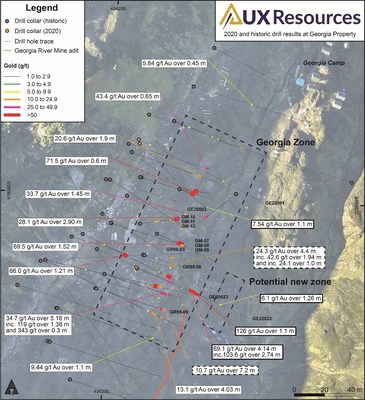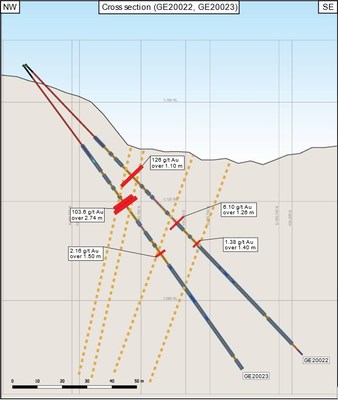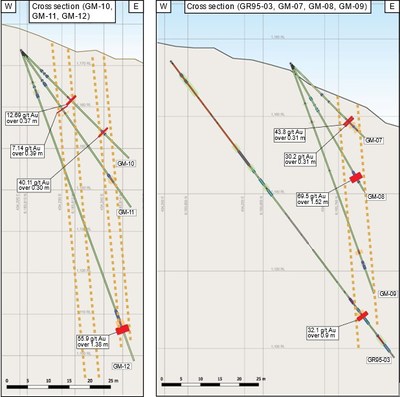Canada NewsWire
VANCOUVER, BC , Feb. 23, 2021 /CNW/ - AUX Resources Corporation (TSXV: AUX) (OTC: AUXRF) is pleased to report the completion of the historic drill hole re-logging and sampling program on the Georgia Project. These results are from previously unsampled diamond drill core by a past operator whose focus had been restricted to high-grade quartz veins. The majority of this historic core was logged, but sampling was restricted to a subset of quartz veins. Forty-six holes were recovered for the program, covering a total of 5,016 metres.
Highlights
- Sampling of historic core extended previously reported intercepts, including two holes that ended in mineralization:
- 24.3 g/t gold over 4.4 metres (GR95-06)
- 10.7 g/t gold over 7.2 metres (GR95-09)
- Sampling of historic core returned new high-grade results, including:
- 20.5 g/t gold over 1.0 metres (GR95-18)
- Improved model for the SW Vein based on combined historic and 2020 data
- Identified a new parallel mineralized zone east of the SW Vein
"We are extremely encouraged by the results of our re-logging and sampling program. We were able to recover over 5,000 metres of historic drill core, which was essentially a second drill program, more than doubling the meterage drilled during the 2020 field season," comments Ian Slater , Chief Executive Officer. "We are not only excited about the high-grade gold results generated from this program, but also about the opportunity to fill in some of the gaps in our geological model and improve our understanding of the style of mineralization at Georgia ."
Historic core from exploration programs between 1979 and 1996 was left on site at the Georgia Project and recovered by AUX during the 2020 field season. The majority of this core was unsampled, providing an opportunity to better constrain the extent and geometry of the mineralized zone without drilling additional metres. Of the historic core on site, 5,016 metres was recoverable and was re-boxed and sent to our facility in Stewart at the end of the 2020 field season, where it was then re-logged and sampled in November 2020 .
|
Program |
Drill Hole |
From (m) |
To (m) |
Width (m) |
Gold (g/t) |
Silver (g/t) |
|
Historic intervals extended by combining historic and re-log data |
GR90-03 |
21.20 |
23.00 |
1.80 |
1.03 |
3.3 |
|
GR90-08 |
67.00 |
69.83 |
2.83 |
2.25 |
1.2 |
|
|
GR95-06** |
35.20 |
39.60 |
4.40 |
24.32 |
n/a |
|
|
including (h) |
35.20 |
37.14 |
1.94 |
42.64 |
n/a |
|
|
and including (r) |
38.60 |
39.60 |
1.00 |
24.10 |
28.7 |
|
|
GR95-09** including (h) |
76.00 80.50 |
83.20 81.66 |
7.20 1.16 |
10.73 58.87 |
n/a |
|
|
GR95-16 |
102.30 |
103.93 |
1.63 |
1.66 |
n/a |
|
|
Newly identified zones from re-log program |
GR90-15** |
79.00 |
81.20 |
2.20 |
1.41 |
10.4 |
|
GR95-08 |
116.00 |
117.00 |
1.00 |
6.33 |
4.2 |
|
|
GR95-12 |
127.00 |
127.80 |
0.80 |
3.18 |
54.9 |
|
|
GR95-14 |
92.65 |
94.00 |
1.35 |
3.22 |
3.1 |
|
|
GR95-18 |
94.00 |
95.00 |
1.00 |
20.50 |
16.4 |
|
|
GR96-11 |
98.50 |
101.50 |
3.00 |
1.80 |
2.8 |
|
|
2020 Drill program |
GE20001 |
95.70 |
96.25 |
0.55 |
5.81 |
7.8 |
|
and |
201.20 |
202.20 |
1.00 |
1.95 |
1.0 |
|
|
GE20003 |
133.65 |
134.75 |
1.10 |
7.54 |
16.5 |
|
|
GE20022 |
60.26 |
62.50 |
2.24 |
62.50 |
36.6 |
|
|
including |
61.40 |
62.50 |
1.10 |
126.00 |
73.8 |
|
|
and |
85.10 |
87.80 |
2.70 |
3.11 |
0.8 |
|
|
including |
86.54 |
87.80 |
1.26 |
6.10 |
1.2 |
|
|
and |
97.65 |
100.40 |
2.75 |
1.07 |
0.7 |
|
|
GE20023 |
66.30 |
70.44 |
4.14 |
69.10 |
35.5 |
|
|
including |
67.70 |
70.44 |
2.74 |
103.60 |
52.7 |
|
|
and |
93.50 |
95.00 |
1.50 |
2.16 |
1.0 |
|
|
Select historic drill results (between 1977 and 2003) |
GGP-5 |
34.30 |
35.75 |
1.45 |
33.70 |
30.0 |
|
including |
34.30 |
34.90 |
0.60 |
78.40 |
0.6 |
|
|
GM-08 |
33.32 |
34.84 |
1.52 |
69.50 |
106.0 |
|
|
including |
33.93 |
34.54 |
0.61 |
140.80 |
219.4 |
|
|
GM-12 |
69.36 |
72.26 |
2.90 |
28.10 |
24.0 |
|
|
GM-20 |
69.21 |
74.39 |
5.18 |
34.70 |
23.1 |
|
|
including |
72.71 |
74.09 |
1.38 |
119.20 |
66.4 |
|
|
and including |
73.48 |
73.78 |
0.30 |
342.50 |
190.6 |
|
|
GR88-01 |
110.79 |
111.28 |
0.49 |
178.30 |
171.0 |
|
|
GR88-02 |
73.61 |
74.82 |
1.21 |
66.00 |
12.3 |
|
|
GR88-07 |
111.76 |
115.79 |
4.03 |
13.12 |
10.9 |
|
|
GR89-01** |
71.6 |
73.5 |
1.90 |
20.60 |
14.7 |
|
|
GR89-04** |
73.10 |
74.80 |
1.70 |
39.20 |
15.7 |
|
|
GR90-11 |
90.02 |
93.00 |
2.98 |
13.50 |
40.3 |
|
|
GR95-02 |
61.87 |
62.47 |
0.60 |
71.50 |
n/a |
|
|
GR96-03 |
96.92 |
98.47 |
1.55 |
22.70 |
n/a |
|
|
and |
108.00 |
109.00 |
1.00 |
3.77 |
2.8 |
Table 1. Significant results from 2020 and historic drilling at the SW Vein, Georgia Project (** indicates the hole ended in mineralization; h and r indicate the interval is from historic and re-log, respectively).
Re-logging was completed to refine the stratigraphy and classify the host rocks to the mineralization according to the lithologies used for the 2020 drill program to improve correlations between historic and new drill holes. Sampling was completed for 3 purposes: 1) to sample prospective areas that had not been previously sampled; 2) to sample the shoulders to veins that had been previously sampled; and 3) to confirm results for select veins that had returned anomalous gold grades in the past. Thirty additional samples were collected for detailed petrographic work to better characterize the host rocks and alteration styles associated with mineralization.
Results from the re-logging and sampling program indicate that the mineralization extends up to several metres outside of the veins and the extent of the mineralized zone is consistent along vein strike. These results combined with the results of the 2020 drill program significantly improve the understanding of the orientation and extent of the mineralized zone. In some cases, historic assay results are combined with those from the re-log to increase the length of mineralized zones. For example, quartz veins sampled towards the bottom of hole GR95-06 returned gold grades of 34.5 and 50.8 g/t gold, but the vein shoulders were not previously sampled. Shoulder sampling of this zone during the re-log program produced a 4.4-metre-long zone grading 24.3 g/t gold, which extends mineralization to the end of the hole – the area below this interval remains open at depth.
SW Vein and Georgia Zone
Mineralization at the Georgia Project was discovered in 1910 and was worked and mined until 1939. Work was centered on the SW Vein, which produced a head grade of 22.6 g/t gold. Historic mine operations were focused approximately 150 metres SSW of the high-grade zone intersected during 2020 drilling (the "Georgia Zone"). One adit extends north from the main mine operations but ends approximately 10 metres into the Georgia Zone. The zone that has been targeted through drilling and exploration after mining operations ceased (including the 2020 drill program) has produced significantly higher grades than what was extracted at the historic Georgia Mine.
Combined data from historic drilling and sampling, re-logging and sampling of historic drill holes, and 2020 drilling and sampling have now been integrated to provide new controls on the orientation and extent of the Georgia Zone. The Georgia Zone is interpreted to be the northern extension of the SW Vein; however, all exploration drilling that has intersected this zone was completed after mining operations ceased and additional drilling is required to assess the continuity of this zone to the south. In addition, 2020 drilling (GE20022) intersected anomalous grades that cannot be correlated with the Georgia Zone, indicating that a separate high-grade target may exist to the east of the Georgia Zone.
Figure 1. Plan view of the Georgia Zone showing 2020 and historic drill results. Historic results are shown with a thin black border, 2020 results are shown with a thick black border, and combined historic and re-log results are shown with a thick dashed black border.
Figure 2a. Cross section looking northeast showing GE20022 and GE20023 (+/- 10 m view window).
Figure 2b . Cross sections looking north showing GM-10, GM-11, GM-12 (left) and GR95-03, GM-07, GM-08, and GM-09 (right; +/ -10 m view window).
Quality Assurance and Control
Samples were analyzed at MSALABS in Langley, Canada (an ISO 9001 accredited facility). The sampling program was conducted by the geological team under the supervision of Dr. Craig Stewart , Exploration Manager. A secure chain of custody was maintained in transporting and storing samples. Gold was assayed using fire assay with atomic absorption spectrometry and gravimetric finish when required (i.e., >9 g/t gold). Analysis by four acid digestion with 48 element ICP-MS analysis was conducted on all samples with silver and base metal overlimits being re-analyzed by emission spectrometry.
About AUX Resources
AUX holds more than 27,000 hectares of strategic claims in the Stewart Mining Camp in the Golden Triangle of British Columbia , which is among the world's most prolific mineralized districts, including the high-grade gold Georgia Project centred on the past-producing Georgia River Mine. The Georgia River Mine, which last operated in 1939 with a head grade of 22.6 g/t gold, contains 1.2 kilometres of underground access on three levels. AUX is actively consolidating the Stewart Mining Camp.
The technical disclosures in this release have been read and approved by Dr. Thomas Mumford , Ph.D., P.Geo., a qualified person as defined in National Instrument 43-101.
Neither the TSX Venture Exchange nor its Regulation Services Provider (as that term is defined in the policies of the TSX Venture Exchange) accepts responsibility for the adequacy or accuracy of this release. This news release includes forward-looking statements that are subject to risks and uncertainties. All statements within, other than statements of historical fact, are to be considered forward looking. Although AUX believes the expectations expressed in such forward-looking statements are based on reasonable assumptions, such statements are not guarantees of future performance and actual results or developments may differ materially from those in forward-looking statements. Factors that could cause actual results to differ materially from those in forward-looking statements include market prices, exploitation and exploration successes, continued availability of capital and financing, and general economic, market or business conditions and regulatory and administrative approvals, processes and filing requirements. There can be no assurances that such statements will prove accurate and, therefore, readers are advised to rely on their own evaluation of such uncertainties. We do not assume any obligation to update any forward-looking statements.
SOURCE AUX Resources Corporation

![]() View original content to download multimedia:
http://www.newswire.ca/en/releases/archive/February2021/23/c9284.html
View original content to download multimedia:
http://www.newswire.ca/en/releases/archive/February2021/23/c9284.html



